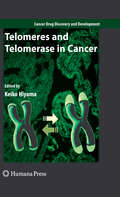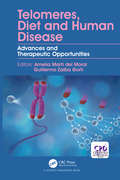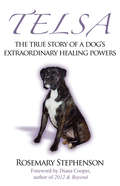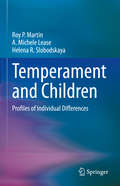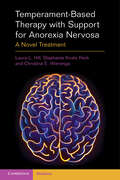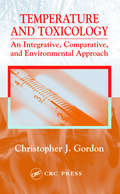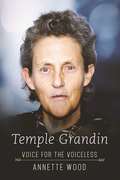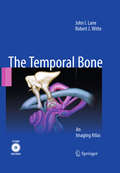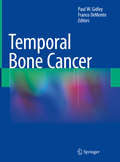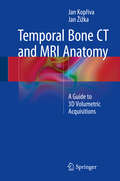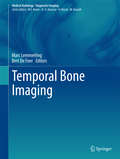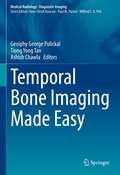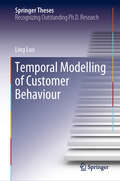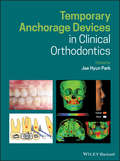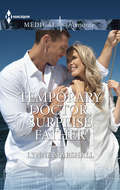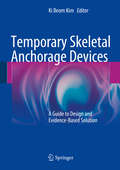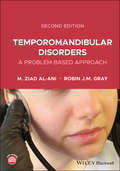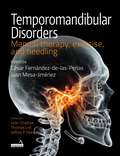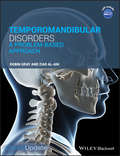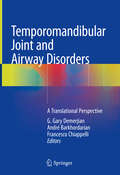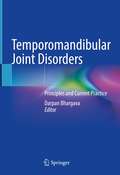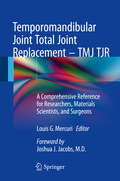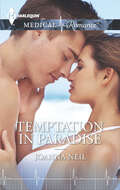- Table View
- List View
Telomeres and Telomerase in Cancer
by Keiko HiyamaTelomerase, an enzyme that maintains telomeres and endows eukaryotic cells with immortality, was first discovered in tetrahymena in 1985. In 1990s, it was proven that this enzyme also plays a key role in the infinite proliferation of human cancer cells. Now telomere and telomerase are widely accepted as important factors involved in cancer biology, and as promising diagnostic tools and therapeutic targets. Recently, role of telomerase in "cancer stem cells" has become another attractive story. Until now, there are several good books on telomere and telomerase focusing on biology in ciliates, yeasts, and mouse or basic sciences in human, providing basic scientists or students with updated knowledge.
Telomeres, Diet and Human Disease: Advances and Therapeutic Opportunities
by Amelia Marti Guillermo ZalbaThe maintenance of telomeres—repetitive sequences at the end of chromosome—is essential to health. Dysfunction in telomere maintenance pathways plays a role in aging, cancer, atherosclerosis and other diseases. This has led to telomere maintenance as a prime target for patient therapies. This book describes the advances in telomere research as it applies to human health and especially how lifestyle and dietary factors could modify the telomerase maintenance process. The book examines the mechanisms involved, the primary of which are oxidative stress and the role of sirtuins, and how they can be modified by dietary patterns such as Mediterranean diet.
Telsa
by Diana Cooper Rosemary StephensonThrough this touching account of the life and work of a boxer named Telsa, the powerful relationship between humans and animals is explored, and the unconditional love shown by a pet is demonstrated as a force that can improve the emotional, mental, and physical well-being of the people around them. The beloved pet of a spiritual healer, Telsa became instrumental in amplifying healing energies throughout her life and even after her passing. Her connection with others and the world around her was unique and immensely positive, and the book follows her story, from her life as a puppy and her invaluable service to nursing home patients to Telsa''s connection to her owner in the after-life.
Temperament and Children: Profiles of Individual Differences
by Roy P. Martin A. Michele Lease Helena R. SlobodskayaThe book presents an empirical model of commonly occurring individual differences in children that is derived from a large-scale research effort assessing parental and teacher perceptions of children in middle childhood. It examines eight characteristic behavioral traits, most of which have been widely shown to be present in infants, toddlers, and preschool-aged children. The book demonstrates the importance of considering profiles of these relatively stable individual differences for the educational, social, and emotional life of the child. It describes characteristic behaviors of children within each profile – emphasizing the assets and liabilities of each – and how they are perceived by their parents, teachers, and peers. Chapters explore issues related to the most developmentally effective management of children exhibiting each profile type.In addition, the book addresses a critical need in child development, parenting, and teaching to understand the wide range of individual differences observed every day in school-aged children. Not only does this volume underscore that commonly occurring differences can be understood as being normal and do not suggest a pathology, it also discusses implications of the model in diagnosing pathology. The book describes what is known about the stability of temperament behaviors and profiles across the lifespan as well as the origins of these behaviors.Key topics addressed include:Nurturing development of well-adjusted children.Causes of individual differences in children’s behavior.Temperamental tendencies and profiles of children.Diagnosing psychopathology in children.This book is a must-have resource for researchers, professors, and graduate students as well as clinicians and related professionals in developmental, clinical child and school psychology, social work, public health, pediatrics, family studies, educational psychology and counseling, and all other interrelated disciplines.
Temperament Based Therapy with Support for Anorexia Nervosa: A Novel Treatment
by Laura L. Hill Stephanie Knatz Peck Christina E. WierengaAnorexia Nervosa has one of the highest death rates of all mental illnesses and one of the poorest treatment outcomes. However, one novel treatment, the neurobiologically-based treatment Temperament-Based Therapy with Supports (TBT-S), works with clients' temperament and traits to motivate change, ultimately managing and reducing symptoms. This practical and accessible book is the first guide to delivering TBT-S that addresses the underlying traits leading to symptoms of anorexia nervosa and helps people to manage symptoms long-term. It offers background information on the role of temperament in anorexia nervosa, the development of the TBT-S protocol and the evidence gathered. Chapters also covers how to augment this therapy into existing treatment. A valuable resource for clinicians involved in the treatment of anorexia nervosa, including psychologists, psychiatrists, psychotherapists, specialist nurses, dieticians, and educators.
Temperament und Kinder: Profile der individuellen Unterschiede
by Roy P. Martin A. Michele Lease Helena R. SlobodskayaDas Buch stellt ein empirisches Modell der häufig vorkommenden individuellen Unterschiede bei Kindern vor, das aus einer groß angelegten Forschungsarbeit abgeleitet wurde, bei der die Wahrnehmungen von Eltern und Lehrern von Kindern in der mittleren Kindheit untersucht wurden. Es werden acht charakteristische Verhaltensmerkmale untersucht, von denen die meisten nachweislich bei Säuglingen, Kleinkindern und Kindern im Vorschulalter vorhanden sind. Das Buch zeigt, wie wichtig die Berücksichtigung von Profilen dieser relativ stabilen individuellen Unterschiede für das pädagogische, soziale und emotionale Leben des Kindes ist. Es beschreibt charakteristische Verhaltensweisen von Kindern innerhalb jedes Profils - wobei die Vorzüge und Nachteile jedes Profils hervorgehoben werden - und wie sie von ihren Eltern, Lehrern und Gleichaltrigen wahrgenommen werden. In den Kapiteln werden Fragen im Zusammenhang mit dem entwicklungsmäßig effektivsten Umgang mit Kindern, die die einzelnen Profiltypen aufweisen, untersucht.Darüber hinaus befasst sich das Buch mit dem kritischen Bedürfnis in der kindlichen Entwicklung, der Elternschaft und dem Unterricht, die große Bandbreite individueller Unterschiede zu verstehen, die täglich bei Kindern im Schulalter beobachtet werden. Dieser Band unterstreicht nicht nur, dass häufig auftretende Unterschiede als normal angesehenwerden können und nicht auf eine Pathologie hindeuten, sondern erörtert auch die Auswirkungen des Modells auf die Diagnose von Pathologien. Das Buch beschreibt, was über die Stabilität von Verhaltensweisen und Profilen des Temperaments über die gesamte Lebensspanne hinweg bekannt ist, sowie die Ursprünge dieser Verhaltensweisen. Zu den wichtigsten Themen gehören: Förderung der Entwicklung von Kindern, die sich gut entwickeln. Ursachen für individuelle Unterschiede im Verhalten von Kindern. Temperamentvolle Tendenzen und Profile von Kindern. Diagnose von Psychopathologie bei Kindern. Dieses Buch ist ein unverzichtbares Hilfsmittel für Forscher, Professoren und Studenten sowie für Kliniker und verwandte Berufsgruppen in den Bereichen Entwicklungs-, klinische Kinder- und Schulpsychologie, Sozialarbeit, öffentliches Gesundheitswesen, Pädiatrie, Familienstudien, pädagogische Psychologie und Beratung sowie allen anderen verwandten Disziplinen.
Temperature and Toxicology: An Integrative, Comparative, and Environmental Approach
by Christopher J. GordonThermoregulation is vital for survival but the interplay between toxic insults and thermoregulatory mechanisms is often poorly understood. Temperature and Toxicology: An Integrative, Comparative, and Environmental Approach is the first major text to study the integrative thermoregulatory responses of mammals that are exposed to toxicants. Because e
Temple Grandin: Voice for the Voiceless
by Annette WoodSince Temple Grandin's life story was told in the 15 x Emmy-nominated film Temple Grandin, and since her heartwarming speech at the award ceremony, she has become one of the world's most well-known members of its community. In this fascinating biography, Annette Wood delves deep into Grandin's life from childhood to adulthood. Wood tells of the trials and tribulations of the icon: What difficulties Grandin struggled with and how she's become a hero for the autistic community. She also tells what Temple has done since the movie came out, where she is today, what kind of difference she's made, and what her future holds. For the 22 million people worldwide afflicted by autism and the countless friends and family members who support them, this brilliant portrait presents an up-close look at the disorder and renewed hope for what the future could bring for those on all levels of the spectrum.
Temporal Bone
by Robert J. Witte John I. LaneImaging of the temporal bone has recently been advanced with multidetector CT and high-field MR imaging to the point where radiologists and clinicians must familiarize themselves with anatomy that was previously not resolvable on older generation scanners. Most anatomic reference texts rely on photomicrographs of gross temporal bone dissections and low-power microtomed histological sections to identify clinically relevant anatomy. By contrast, this unique temporal bone atlas uses state of the art imaging technology to display middle and inner ear anatomy in multiplanar two- and three-dimensional formats. In addition to in vivo imaging with standard multidetector CT and 3-T MR, the authors have employed CT and MR microscopy techniques to image temporal bone specimens ex vivo, providing anatomic detail not yet attainable in a clinical imaging practice. Also included is a CD that allows the user to scroll through the CT and MR microscopy datasets in three orthogonal planes of section.
Temporal Bone Cancer
by Paul W. Gidley Franco DeMonteThis volume comprehensively reviews the current literature on temporal bone cancer and the multidisciplinary approaches used to managing these rare tumors. The text will review important medical issues as they specifically relate to temporal bone cancer such as advanced imaging, pathologic classification, skull base surgery, plastic reconstructive surgery, and advances in osseointegrated implants for hearing restoration. Additional chapters are dedicated to the evaluation and management, diagnostic radiology, surgical planning and techniques, radiotherapy, chemotherapy, and rehabilitation. An emphasis is placed on the multidisciplinary approach required for the optimal care of these rare tumors. Written by leaders in the field, Temporal Bone Cancer will be an invaluable resource for residents and fellows in Otolaryngology, Neurosurgery and Neurotology, and clinicians with interest in the primary tumors of the temporal bone.
Temporal Bone CT and MRI Anatomy
by Jan Kopřiva Jan ŽižkaThis book, featuring more than 180 high spatial resolution images obtained with state-of-the-art MDCT and MRI scanners, depicts in superb detail the anatomy of the temporal bone, recognized to be one of the most complex anatomic areas. In order to facilitate identification of individual anatomic structures, the images are presented in the same way in which they emanate from contemporary imaging modalities, namely as consecutive submillimeter sections in standardized slice orientations, with all anatomic landmarks labeled. While various previous publications have addressed the topic of temporal bone anatomy, none has presented complete isotropic submillimeter 3D volume datasets of MDCT or MRI examinations. The Temporal Bone MDCT and MRI Anatomy offers radiologists, head and neck surgeons, neurosurgeons, and anatomists a comprehensive guide to temporal bone sectional anatomy that resembles as closely as possible the way in which it is now routinely reviewed, i. e. , on the screens of diagnostic workstations or picture archiving and communication systems (PACS).
Temporal Bone CT and MRI Anatomy: A Guide to 3D Volumetric Acquisitions
by Jan Kopřiva Jan ŽižkaThis book, featuring more than 180 high spatial resolution images obtained with state-of-the-art MDCT and MRI scanners, depicts in superb detail the anatomy of the temporal bone, recognized to be one of the most complex anatomic areas. In order to facilitate identification of individual anatomic structures, the images are presented in the same way in which they emanate from contemporary imaging modalities, namely as consecutive submillimeter sections in standardized slice orientations, with all anatomic landmarks labeled. While various previous publications have addressed the topic of temporal bone anatomy, none has presented complete isotropic submillimeter 3D volume datasets of MDCT or MRI examinations. The Temporal Bone MDCT and MRI Anatomy offers radiologists, head and neck surgeons, neurosurgeons, and anatomists a comprehensive guide to temporal bone sectional anatomy that resembles as closely as possible the way in which it is now routinely reviewed, i.e., on the screens of diagnostic workstations or picture archiving and communication systems (PACS).
Temporal Bone Imaging
by Marc Lemmerling Bert FoerThis book provides a complete overview of imaging of normal and diseased temporal bone. After description of indications for imaging and the cross-sectional imaging anatomy of the area, subsequent chapters address the various diseases and conditions that affect the temporal bone and are likely to be encountered regularly in clinical practice. The classic imaging methods are described and discussed in detail, and individual chapters are included on newer techniques such as functional imaging and diffusion-weighted imaging. There is also a strong focus on postoperative imaging. Throughout, imaging findings are documented with the aid of numerous informative, high-quality illustrations. Temporal Bone Imaging, with its straightforward structure based essentially on topography, will prove of immense value in daily practice.
Temporal Bone Imaging Made Easy (Medical Radiology)
by Geoiphy George Pulickal Tiong Yong Tan Ashish ChawlaThis book presents standard imaging techniques, basic anatomy and an approach to common pathology encountered in temporal bone imaging. Intended as a survival guide for residents and general radiologists, it covers all topics comprehensively, and provides intuitive point-by-point summaries, similar to those of popular radiology reference sites, for easy comprehension at a glance. The book also offers guidance on the pertinent points that need to be included in a report and how to answer basic questions that are likely to be asked by the referring clinician or supervising radiologist. This book will be a valuable resource for general radiologists, radiology residents, ENT residents, otology surgeons and anyone involved in the occasional temporal bone study.
Temporal Modelling of Customer Behaviour (Springer Theses)
by Ling LuoThis book describes advanced machine learning models – such as temporal collaborative filtering, stochastic models and Bayesian nonparametrics – for analysing customer behaviour. It shows how they are used to track changes in customer behaviour, monitor the evolution of customer groups, and detect various factors, such as seasonal effects and preference drifts, that may influence customers’ purchasing behaviour. In addition, the book presents four case studies conducted with data from a supermarket health program in which the customers were segmented and the impact of promotional activities on different segments was evaluated. The outcomes confirm that the models developed here can be used to effectively analyse dynamic behaviour and increase customer engagement. Importantly, the methods introduced here can also be used to analyse other types of behavioural data such as activities on social networks, and educational systems.
Temporary Anchorage Devices in Clinical Orthodontics
by Jae Hyun ParkProvides the latest information on all aspects of using temporary anchorage devices in clinical orthodontics, from diagnosis and treatment planning to appliances and applications Written by some of the world’s leading experts in orthodontics, Temporary Anchorage Devices in Clinical Orthodontics is a comprehensive, up-to-date reference that covers all aspects of temporary anchorage device (TAD) use in contemporary orthodontics. Taking a real-world approach to the subject, it covers topics ranging from diagnosis and treatment planning to the many applications and management of complications. Case studies demonstrate the concepts, and high-quality clinical photographs support the text throughout. The book begins with an overview of clinical applications and fundamental principles of TADs. It then goes on to cover biomechanical considerations for controlling target tooth movement with TADs. Biomechanical simulations for various clinical scenarios treated with TADs are addressed next, followed by an examination of histological aspects during the healing process and anatomical considerations with TADs. Other chapters cover: Class II Correction with TADs, Distalization with TADs, TAD-anchored Maxillary Protraction, Maxillary Expansion with TADs, Anterior Open Bite Correction with TADs, TAD-assisted Aligner Therapy, TADs vs. Orthognathic Surgery; Legal Considerations When Using TADs; and much more. Provides evidence-based information on the use of TADs, with a focus on improving outcomes for patients Considers topics ranging from diagnosis and treatment planning to specific clinical applications and appliances Takes a real-world clinical approach, with case studies demonstrating concepts Written by international experts in the field Presents hundreds of high-quality clinical photographs to support the text Temporary Anchorage Devices in Clinical Orthodontics is an essential resource for orthodontists and orthodontic residents.
Temporary Doctor, Surprise Father
by Lynne MarshallHer baby secret…<P> One-time bad-boy Beck Braxton has been assigned a temporary role of the ER department of his old local LA hospital. He's fine until he discovers that the nurse he’ll be working with is the woman who broke his heart thirteen years ago…<P> Of all the ER’s in all the world, he had to walk into hers. Jan can’t believe the rogue she’s never been able to forget is back in her life! While he’s changed, Beck is still as devastating as ever - and the chemistry between them is still very much alright…<P> Now all Jan must do is to tell him her secret … that Beck is the father of her child!
Temporary Skeletal Anchorage Devices
by Ki Beom KimAnchorage control is one of the most challenging tasks in orthodontic treatment Many different types of appliance are used to control anchorage, but an excellent outcome may be difficult to achieve owing to either poor mechanics or inadequate patient compliance. Recently, temporary skeletal anchorage devices (TSADs) have become popular in orthodontics. Some orthodontic movements that are now possible using TSADs were previously considered almost impossible with traditional orthodontic appliances. Several different types of TSAD are currently available, and in choosing between them orthodontists are obliged to rely on the information provided by manufacturers, which is often not based on scientific evidence. This book therefore presents the various design characteristics of TSADs and provides up-to-date scientific evidence to assist orthodontists in selecting the best TSADs for their patients.
Temporomandibular Disorders: A Problem-Based Approach (Dental Update Ser.)
by M. Ziad Al-Ani Robin J. GrayA valuable resource on how to diagnose and treat temporomandibular disorders (TMD) The newly and thoroughly revised 2nd Edition of Temporomandibular Disorders: A Problem-Based Approach delivers a systematic and logical approach to diagnosing and treating temporomandibular disorders. Using a case-based approach to assist readers with understanding and retention, the book discusses the practical realities of managing patients and promoting effective treatment of temporomandibular disorders. Containing full colour clinical images and diagrams throughout, the chapters include practical guides on how to make splints and samples of patient information sheets which can be used as templates. Readers will get access to topics such as: The clinical aspects of anatomy, function, pathology, and classification Differential diagnosis of temporomandibular joint problems Clicking joint problems and the use of preliminary investigation in disc displacement Temporomandibular joint locking diagnosis and treatment, including final treatment plans Facial pain examinations, differential diagnosis, and questions to ask patients regarding pain in general Headaches, worn teeth, dislocated jaws, and more issues that arise in the treatment of temporomandibular joint problems Perfect for undergraduate dental students and general dental practitioners, the new edition of Temporomandibular Disorders is also useful to postgraduate dental students, academics, and researchers.
Temporomandibular Disorders: Manual therapy, exercise, and needling
by César Fernández-de-las-PeñasAn authoritative and comprehensive account of the assessment and conservative management of temporomandibular disorders. Recent emphasis has been on 'evidence-based practice' at the expense of the clinical reality which should also take account of clinician expertise and patient preference. A sound research base is not always available. This text addresses the clinical reality of having to make decisions using other sources of knowledge in the absence of a comprehensive scientific rationale. It advocates clinical and evidence-informed practice - an approach which acknowledges the value of clinician experience and expertise as well as research findings.Compiled and edited by two highly regarded and experienced practitioners, researchers and authors who have already published many books and journal articles in the field. With contributions from a mix of 28 internationally-based clinicians and clinician-researchers allowing the text to highlight both current best evidence and clinicians' expertise and experience. Contributors include talented young clinicians as well as established experts in orthopaedic physiotherapy and world-level expert researchers.
Temporomandibular Disorders: A Problem-Based Approach
by Robin J. Gray M. Ziad Al-AniA quick, systematic and logical approach to diagnosing and treating temporomandibular disorders (TMD), this latest book in the Dental Update series is an essential clinical companion for dental students and practising dentists. Starting with an overview of the basic principles of TMD, such as the anatomy of the temporomandibular joint and its physiology and pathology in relation to clinical treatment, the book goes on to present the realities of managing patients, using a case-based approach to help readers understand and engage with the information. Each later chapter presents a different problem in the form of a case study, and each study features a systematic approach to aid learning. Temporomandibular Disorders: A Problem-Based Approach promotes learning as a dynamic process of active involvement. It encourages valuation by self-assessment with questions at the end of the book, and a unique link to an online interactive quiz where readers can test their knowledge of TMD. The final chapters include practical guides of how to make splints and samples of patient information sheets that can be used as templates. The book is illustrated in full colour, with helpful clinical images and diagrams. KEY FEATURES Uses a case-based approach to promote effective management of TMD Covers basic scientific background as well as clinical scenarios Addresses not only ‘why’ but also ‘how’ with a highly practical focus Includes a unique link to an online interactive quiz (visit www.wiley.com/go/gray) Contains many full colour clinical images and diagrams
Temporomandibular Joint and Airway Disorders: A Translational Perspective
by G. Gary Demerjian André Barkhordarian Francesco ChiappelliThis book on the local and systemic manifestations and correlates of temporomandibular joint disorders (TMDs) encompasses the two intertwined facets of translational science – translational research and translational effectiveness – as they relate specifically to TMDs. The first part of the book, on recent translational research, focuses on topics such as the neuroanatomy and neurophysiology of the trigeminal nerve and trigeminal network system, the manifestations of neuroinflammation in TMDs, and the molecular mechanisms underlying TMDs. The second part discusses the clinical effectiveness of treatment approaches from the perspective of evidence-based dentistry, with careful attention to the critical relationships between dental malocclusions, the signs and symptoms of TMDs, and airway/breathing disorders. Interventions to correct for malocclusal conditions that lead to TMDs are examined, with explanation of the ways in which they can ameliorate a variety of local and systemic symptoms. This will be an excellent reference book for established practitioners, residents, interns, and students as well as a powerful cutting-edge document for researchers in the field.
Temporomandibular Joint Disorders: Principles and Current Practice
by Darpan BhargavaThis book is designed to provide a crisp and necessary information for all the under-graduate and post-graduate medical students, Oral and Maxillofacial Surgeons, ENT Surgeons, General Surgeons, General Dentists and other health care workers who deal with TMDs in their practise. It includes contributions from eminent surgeons across the world who treat TMJ disorders and diseases using various conventional to modern state of the art techniques. Temporomandibular joint disorders (TMDs) are familiar yet difficult to diagnose in routine practice due to the complexity of the joint and its surrounding structures. The symptoms usually associated with TMDs present with pain, joint sounds such as click or crepitus, difficulty during mastication, reduced mouth opening are some of the many presentations. Definite diagnosis of the TMDs can be challenging as the patients present with varying symptoms. These disorders of the joint can vary from a simple disc displacement to complex pathologies. Management of the TMDs can be tricky and hence need a thorough evaluation of the joint and surrounding structures. There has been a tremendous leap in managing these disorders from simple conservative management to several advanced surgeries to salvage the joint. This compilation highlights all the relevant details regarding TMDs and its management which will offer utmost details to practising surgeons who often deal with TMDs. This book will be a delight to read for all the clinicians and surgeons who are interested in treating the small yet complex jaw joint in the facial region.
Temporomandibular Joint Total Joint Replacement - TMJ TJR
by Louis G. MercuriThis is the first text that deals specifically with TMJ TJR. Each chapter is authored by either a basic science researcher or clinician known for their interest and expertise in this field. The text provides the reader with state-of-the-art analysis of all aspects of total temporomandibular joint replacement (TMJ TJR), starting with cutting-edge evidence on the biomechanics of the TMJ. The intriguing history of TMJ TJR is presented to provide an understanding of why some prior TMJ TJR devices failed and how what was learned from those failures has led to the improvements exhibited in present TMJ TJR devices. Expert chapters discuss both stock and custom designs, their indications and contraindications, primary operative techniques, combined TMJ TJR and orthognathic surgical techniques, and the devices' adaption for use as segmental or total mandibular replacement devices after ablative surgery. Clinical outcomes and avoidance as well as management of complications are detailed. Numerous helpful illustrations and radiographs are presented to assist readers in understanding and carrying out the described procedures. Important evidence from both the orthopedic and TMJ TJR literature relating to material sensitivity and mechanical wear will be reported. Finally, the role bioengineered tissue may hold for the future of TMJ TJR will be discussed.
Temptation in Paradise
by Joanna NeilIn this sweet contemporary romance, an escape from heartbreak sends a doctor to sunnier climes and an off-limits attraction to her new boss.Pediatrician Jessie Heywood has arrived in the Caribbean ready to leave her heartbreak behind and focus on the future. Romance is the last thing on her mind, but when she meets Dr. José Benitez she finds herself facing the ultimate temptation. Because José is the one man she shouldn’t want—her boss. Her interlude in paradise was supposed to be temporary, but with the passion between them blazing hotter than the sun, Jessie suddenly finds herself wanting to stay forever . . .
